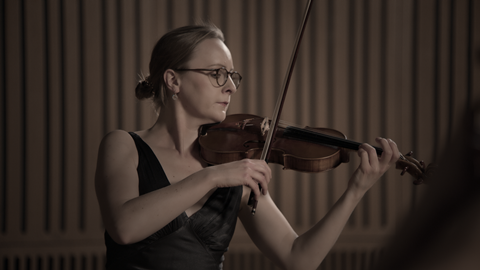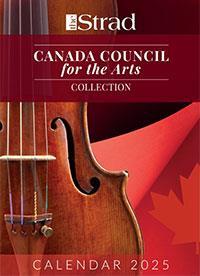Violinist Jane Gordon explores thoughts and ideas behind warm-ups using the Alexander Technique

Discover more Featured Stories like this in The Strad Playing Hub
Just as we learn the art of practising, we also need to develop healthy ways to warm up. These can have a dual function, both to get the muscles ready to play but also to refine technique and isolate particular movements with awareness of our body use.
Warm-ups are distinctly individual. How can we be most efficient with our time and maximise results for technical challenges? What are healthy playing habits and how can warm-ups help?
As a violinist trained in Alexander Technique (AT), I enjoy a holistic approach to playing and it helps keeps me in good shape. I consider the use of the body as a whole, having awareness of my back, stance, feet etc as well as the muscles more closely related with playing. I regard AT as a kind of mindfulness in action.
The Alexander Technique is an invaluable tool for learning to sense and let go of unwanted tensions and ingrained habits that can get in the way of playing. It is important to play with efficient muscle use to avoid fatigue or injury and to develop stamina.
Over time, the healthy habit of fine-tuning my body is easier to establish and carries over into my playing. I’m endlessly learning how to sense my body, just as sensitively as I have been trained to approach my violin and listen to the sounds I make. My sound is freer, nuances more effortless and body language more integral. It is a refreshing approach to feeling increasingly at one with my musical intention and musicality.
Here’s my list of top tips for warm-ups to begin working holistically.
1. Semi-supine & body mapping
Lie on a yoga mat with your head supported on a book and your knees up, pointing to the ceiling. Bring your attention to the feeling of your back on the floor and use the yoga mat to get sensory feedback. Can you allow your spine to soften and switch off? Do you feel wonky? Are there any muscles in your back that you can release to help straighten up?
Next, scan your whole body, starting at the toes, going through the legs, torso, shoulders, neck and head. See if you can feel heavy or relaxed as you go though the process. Gently get up and play a few notes and observe any changes.
Purpose: This primes our body for playing. Semi-supine is also our constructive rest. Done before playing, it helps us start in ‘neutral’ and done in a practice break, it is the perfect rest and promotes optimal playing health.It’s very tempting to skip it, especially with a heavy workload of repertoire, but even a few minutes can be very beneficial.
2. Grounding feet
Before playing, bring your attention to your feet for a few moments. Ideally without shoes on, shift your body weight gently forward and backwards, side to side, and come to rest where comfortable, more or less central. Now play open strings (three or four crotchets to a bow) and allow the bowing arm to swing back and forth with ease. Bringing your attention back to your feet while playing, is there anything changing? Has any tension crept in? Is there a gentle movement in your ankles, in response to the bowing, that feels good? Are you holding any unnecessary tension in your legs or back?
If you’re playing sitting down, the same warm-up can be applied thinking of the sitting bones on the chair combined with the feet.
The purpose of this exercise is to start listening to the whole body while playing. The feet are our roots.
3. Breathing - relax the exhale
If you have ever noticed heavy breathing or gasping during playing, then here’s a warm-up to play with. Take a few moments to sit still and calming watch your breathing. When you’re comfortable, allow yourself to gently exhale, focus on relaxing as you get to the end of the breath. What does this place feel like before you inhale again? Is this pause before your next breath comfortable? Can you then wait for the inhale to happen by itself? Does this subsequent inhale feel any lighter?
Now playing a short piece of music (I usually take a section of unaccompanied Bach). Calmly watch your breathing while playing. Can you relax the exhale (without the pause in the exercise, just normal breathing)? Is there anything changing and feeling freer in the upper body?
The purpose of this exercise is to make our breathing as easy as possible. The aim is to facilitate us to be expressive without the tension in heavy breathing.
4. Balancing the violin - harmonics and shifting
Circle your shoulders gently backwards a few times then forwards. Body-mapping tip: our arms connect right to the end of our collar bones (think below your chin). It can feel good to encourage gentle movement forward using the collar bones.
Pick up the violin and play natural harmonics in fifth position with the third finger. Allow the left elbow to ‘feel gravity’ as it hangs towards the floor, allowing it to adjust across each string.
From the same harmonic starting point as ‘home’;
1) Shift an octave higher and back, opening up the left hand at the base of the thumb. Shift down to first position and back allowing the elbow to open up.
2) Lightly slide all four fingers at once (harmonic pressure) from first position right up the fingerboard as high as possible and down again. Notice how the wrist, elbow and shoulder joints need to accommodate this. Can they be made to feel any easier? Is there any unnecessary tension? Are all the fingers comfortable and able to stay lightly in contact with the fingerboard? If not, what needs adjusting?
Purpose - the new ‘home position’ halfway up the fingerboard encourages comfort and reduced tension in higher positions. The shifting allows all the joints of the left arm (wrist, elbow, shoulder) to flow and keep mobile without tension.
I also do this warm-up without my shoulder rest to encourage my shoulders to feel freer. Violinists’ shoulders are often restricted by shoulder rests. Years of keeping the instrument in one position can build up muscle tension and discomfort.
5. Play and listen to the silence
Pick any note and play a short quaver on an open string. Wait and listen to the reverberations.
Next, imagine you are going to play the note again but stop, don’t play it. Wait a moment, then go to play the note again. Listen to the reverberation and don’t ‘try’ to play the short note.
Repeat the exercise - imagine, stop, play - seeing if you notice any unwanted tension as the bow comes to the string.
Do you notice yourself physically anticipating playing the note?
The more you focus on the reverberation and less on playing the actual note, does anything change? Can you imagine the sound in 360 degrees, behind you as well as in front?
Purpose - This is an exercise in identifying ingrained habits in anticipation of playing. We are also playing mind tricks by directing our attention to the sound after the note, not during. By listening behind us and thinking of sound in 360 degrees, it also helps us not try too hard and develop easier projection.
6. Playing repertoire or etudes
At this stage, I usually do some Ševčík exercises followed by slow practice, working on repertoire under tempo with relaxed arms. It’s useful to carry over the mindfulness of the holistic warm-ups as much as possible.
Move on to any typical finger or bowing warm-ups that you have in your routine, see if you can sense any ingrained habits or unwanted tension in the body as a whole. Can your standard warm-ups be done more mindfully?
Jane’s latest recording with the Rautio Piano Trio of Beethoven Piano Trios Op.1 Nos. 1/2 with fortepiano is out now on Resonus Classics. Find it on Spotify here.
Read: Musicians and exercise: Can a keep fit regime make you a better string player?
Read: How I warm up: Hilary Hahn
Discover more Featured Stories like this in The Strad Playing Hub
The number one source for playing and teaching books, guides, CDs, calendars and back issues of the magazine.
In The Best of Technique you’ll discover the top playing tips of the world’s leading string players and teachers. It’s packed full of exercises for students, plus examples from the standard repertoire to show you how to integrate the technique into your playing.
In the second volume of The Strad’s Masterclass series, soloists including James Ehnes, Jennifer Koh, Philippe Graffin, Daniel Hope and Arabella Steinbacher give their thoughts on some of the greatest works in the string repertoire. Each has annotated the sheet music with their own bowings, fingerings and comments.
The Canada Council of the Arts’ Musical Instrument Bank is 40 years old in 2025. This year’s calendar celebrates some its treasures, including four instruments by Antonio Stradivari and priceless works by Montagnana, Gagliano, Pressenda and David Tecchler.
Best of 2023: The Strad Playing Hub

Revisit our most-viewed playing articles from the last twelve months
- 1
- 2
- 3
- 4
- 5
 Currently
reading
Currently
reading
6 holistic warm-ups for violinists
- 7
- 8
- 9
- 10
- 11































































No comments yet